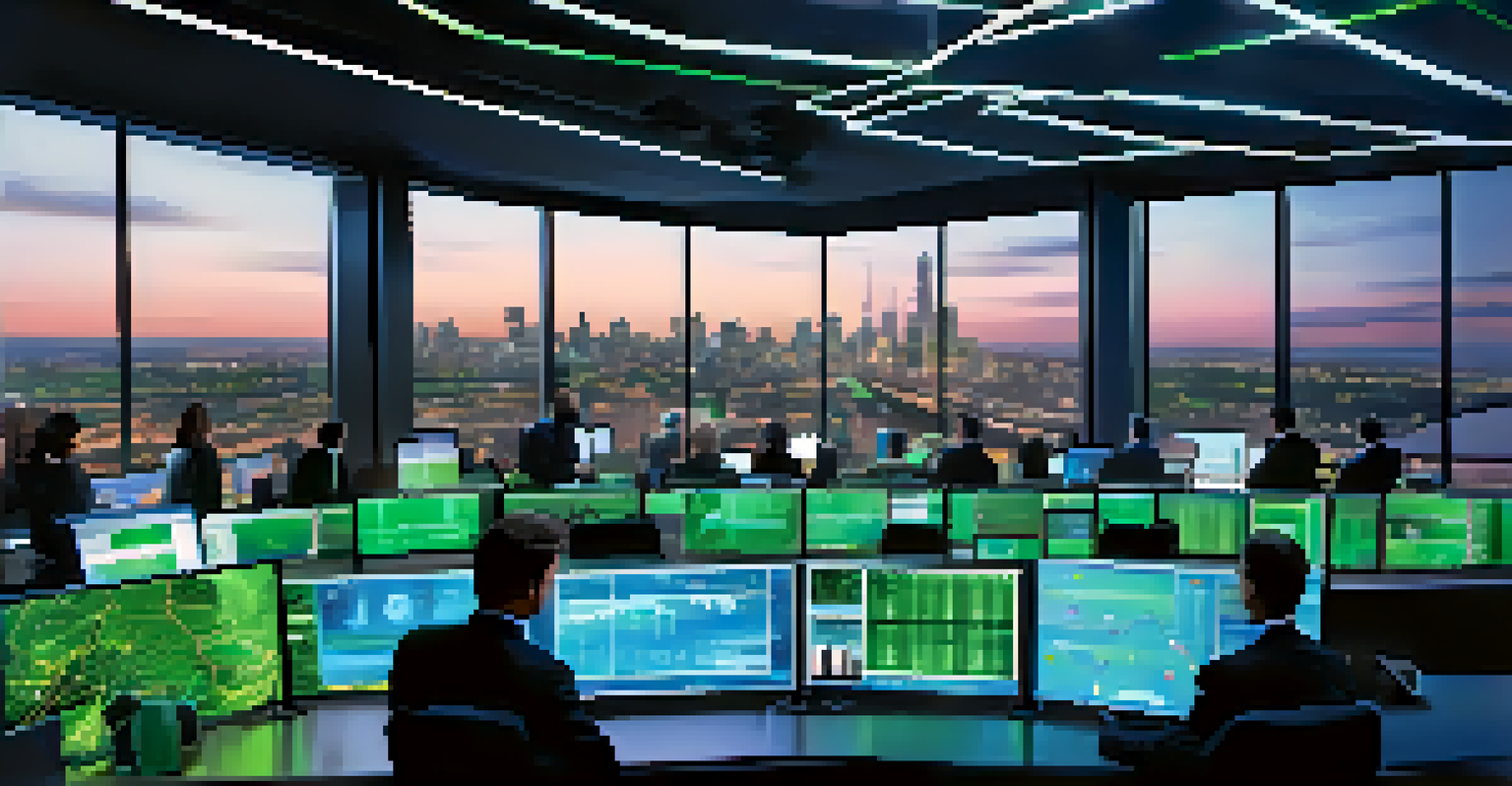Cyber-Physical Systems in Smart Cities: A Comprehensive Guide

Understanding Cyber-Physical Systems and Their Importance
Cyber-Physical Systems (CPS) refer to the integration of computation, networking, and physical processes. In the context of smart cities, these systems play a critical role in enhancing urban infrastructure. They combine sensors, software, and physical entities to create a seamless interaction between the digital and physical worlds.
The cities of the future will be built on the foundations of cyber-physical systems, where technology and urban life harmoniously coexist.
For example, think of CPS as the nervous system of a city, where data flows like signals through nerves, enabling the city to respond to the needs of its inhabitants. This integration not only improves efficiency but also enhances safety and sustainability. As urban areas grow, the significance of CPS becomes even more pronounced, paving the way for smarter solutions.
Moreover, CPS can facilitate real-time data collection and analysis, enabling city planners to make informed decisions. This can lead to better resource management, reduced traffic congestion, and improved public safety. In essence, CPS serves as the backbone of smart cities, driving innovations that enhance the quality of urban life.
Key Components of Cyber-Physical Systems in Smart Cities
The foundation of any effective cyber-physical system in a smart city includes sensors, actuators, and communication networks. Sensors collect data from the environment—like traffic flow, air quality, or energy usage—while actuators execute actions based on that data. Communication networks then ensure that this data flows smoothly between devices and systems.

For instance, imagine a smart traffic management system that uses sensors to monitor vehicle flow. When congestion is detected, the system can automatically adjust traffic signals to ease the buildup. This dynamic response is made possible by the seamless interaction between the components of CPS, showcasing their ability to enhance urban functionality.
CPS: Backbone of Smart Cities
Cyber-Physical Systems integrate digital and physical components to enhance efficiency, safety, and sustainability in urban environments.
Additionally, advanced technologies such as the Internet of Things (IoT) and artificial intelligence (AI) are integral to modern CPS. IoT connects various devices, while AI analyzes the data, leading to smarter decision-making. Together, these components create a robust infrastructure that supports the dynamic needs of a modern city.
Applications of Cyber-Physical Systems in Smart Urban Environments
Cyber-Physical Systems find a multitude of applications in smart cities, ranging from transportation management to energy distribution. In transportation, CPS can optimize traffic flow and improve public transit systems, making commutes more efficient and environmentally friendly. This not only enhances mobility but also reduces the carbon footprint of urban areas.
Data is the new oil, and in smart cities, it fuels the innovation and efficiency that are essential for sustainable living.
Another area where CPS excels is in smart energy grids. By utilizing real-time data, cities can better manage energy supply and demand, making it possible to integrate renewable energy sources effectively. This leads to more sustainable energy consumption patterns, ultimately benefiting both the environment and residents.
Moreover, CPS can enhance public safety through smart surveillance systems and emergency response management. For instance, in the event of a natural disaster, a cyber-physical system can gather data on affected areas and deploy resources effectively. This proactive approach demonstrates how CPS plays a crucial role in ensuring the safety and resilience of urban environments.
Challenges of Implementing Cyber-Physical Systems in Cities
Despite their numerous benefits, implementing Cyber-Physical Systems in smart cities comes with challenges. One of the primary concerns is data privacy and security. As cities become more interconnected, the risk of cyberattacks increases, making it essential to safeguard sensitive information.
Another challenge is the integration of legacy systems with new technologies. Many cities still rely on outdated infrastructure, which can complicate the implementation of CPS. Overcoming this hurdle requires significant investment and strategic planning to ensure a smooth transition.
Data Drives Urban Decision-Making
Massive amounts of data generated from various sources empower city planners to make informed decisions for better resource management.
Additionally, there is a need for public acceptance and understanding of these systems. Educating citizens on the benefits and safety of CPS is vital for fostering trust and encouraging widespread adoption. Addressing these challenges is crucial for realizing the full potential of CPS in smart cities.
The Role of Data in Cyber-Physical Systems
Data serves as the lifeblood of Cyber-Physical Systems, driving their functionality and effectiveness. In smart cities, massive amounts of data are generated from various sources, including sensors, cameras, and social media. This data provides valuable insights into urban dynamics, helping city planners make informed decisions.
For example, analyzing traffic data can reveal patterns that lead to better road design or public transportation routes. By harnessing this information, cities can proactively address issues before they escalate. In essence, data not only informs actions but also enables continuous improvement of urban systems.
However, managing this data effectively poses its own set of challenges. Cities must implement robust data management systems to ensure accuracy, security, and accessibility. Balancing the need for data utilization with privacy concerns is key to creating a successful Cyber-Physical System in a smart city.
Future Trends in Cyber-Physical Systems for Smart Cities
As technology continues to evolve, the future of Cyber-Physical Systems in smart cities looks promising. Emerging technologies such as 5G networks and edge computing are set to enhance the performance of CPS significantly. With faster data transmission and processing capabilities, cities can respond to real-time events more effectively.
Moreover, the integration of artificial intelligence and machine learning will lead to even smarter urban systems. These technologies can analyze data patterns and make autonomous decisions, further optimizing resources and services. For instance, AI could predict traffic congestion and reroute vehicles before issues arise.
Future Trends in Urban Innovation
Emerging technologies like 5G and AI will significantly enhance the performance of Cyber-Physical Systems in creating smarter, more resilient cities.
Sustainability will also be a key trend as cities strive to reduce their environmental impact. CPS will play a vital role in this by optimizing energy consumption and promoting sustainable practices. The future holds exciting possibilities for Cyber-Physical Systems, driving innovations that enhance urban living.
Conclusion: Embracing Cyber-Physical Systems for Better Cities
In conclusion, Cyber-Physical Systems are transforming the way we interact with our urban environments. By integrating digital and physical components, cities can enhance efficiency, safety, and sustainability. Embracing these systems is not just a trend; it’s a necessity for modern urban living.
As we look towards the future, the potential for CPS in smart cities is vast. From improved transportation to smarter energy management, the benefits are numerous and impactful. However, addressing the challenges associated with implementation is crucial for realizing these benefits fully.

Ultimately, a collaborative effort involving city planners, technology providers, and the community will be essential in harnessing the full potential of Cyber-Physical Systems. By working together, we can create smarter, more resilient cities that enhance the quality of life for all residents.